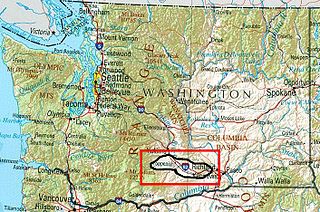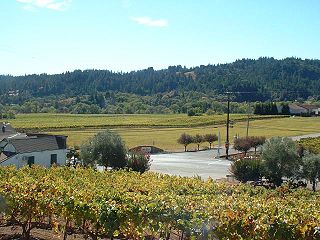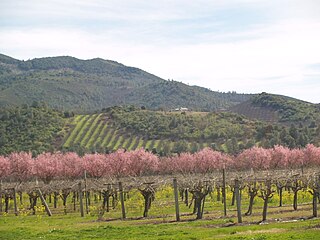
Washington wine is a wine produced from grape varieties grown in the U.S. state of Washington. Washington ranks second in the United States in the production of wine. By 2017, the state had over 55,000 acres (220 km2) of vineyards, a harvest of 229,000 short tons (208,000 t) of grapes, and exports going to over 40 countries around the world from the 940+ wineries located in the state. While there are some viticultural activities in the cooler, wetter western half of the state, the majority (99.9%) of wine grape production takes place in the shrub-steppe eastern half. The rain shadow of the Cascade Range leaves the Columbia River Basin with around 8 inches (200 mm) of annual rain fall, making irrigation and water rights of paramount interest to the Washington wine industry. Viticulture in the state is also influenced by long sunlight hours and consistent temperatures.
The state of Oregon in the United States has established an international reputation for its production of wine, ranking fourth in the country behind California, Washington, and New York. Oregon has several different growing regions within the state's borders that are well-suited to the cultivation of grapes; additional regions straddle the border between Oregon and the states of Washington and Idaho. Wine making dates back to pioneer times in the 1840s, with commercial production beginning in the 1960s.

Columbia Gorge is an American Viticultural Area (AVA) which includes land surrounding the Columbia River Gorge, straddling the border between Oregon and Washington. The AVA was established by the Alcohol and Tobacco Tax and Trade Bureau {TTB), Treasury on July 9, 2004 after reviewing the petition submitted by Mark Wharry, on behalf of the Columbia River Gorge Wine Growers Association, proposing the viticultural area named "Columbia Gorge." The 280 square miles AVA is located about 60 miles (97 km) east of Portland, Oregon, straddles the Columbia River for 15 miles (24 km), and extends into south-central Washington and north-central Oregon. The area surrounds Hood River, Oregon, and White Salmon, Washington, and is generally bordered by B Z Corner, Washington, on the north; Lyle, Washington, on the east; Parkdale, Oregon, on the south; and Vinzenz Lausmann State Park, Oregon, on the west. The area is just west of the established Columbia Valley viticultural area and shares a border with it. Due to the significant gradations of climate and geography found in the gorge, this AVA exhibits a wide range of terroir in a relatively small region; it is marketed as a "world of wine in 40 miles".

Columbia Valley is an American Viticultural Area (AVA) which lies within the Columbia River Plateau, through much of central and southern Washington state, with a section crossing the state boundary into northern Oregon south of the Columbia River. The viticultural area includes the drainage basin of the Columbia River and its tributaries through much of Washington. It was established by the Bureau of Alcohol, Tobacco and Firearms (ATF), Treasury on December 13, 1984 after evaluating the petition filed by Drs, Walter Clore and Wade Wolfe of Prosser, Washington on behalf of Washington’s oldest and largest winery, Chateau Ste. Michelle, and by William Blosser of the Sokol Blosser Winery, Dundee, Oregon. Allen Shoup, president of Chateau Ste. Michelle, understood the importance of obtaining appellation status to grow the reputation of the Northwest viticulture industry.

Yakima Valley is the first American Viticultural Area (AVA) established within Washington state, gaining the recognition on May 4, 1983. Within the vast Columbia Valley AVA, Yakima Valley appellation cultivates more than 53,000 acres (21,448 ha) giving the region the largest concentration of wineries and vineyards in the state. The most widely planted varietals in the area are Chardonnay, Riesling, Merlot, Cabernet Sauvignon, Pinot gris, and Syrah. Nearly 40% of Washington's annual wine production is made from Yakima Valley grapes. In addition to grapes, the Yakima Valley is also home to several fruit orchards growing apples, cherries, nectarines, peaches, pears and plums. Around the town of Zillah, there is the Zillah Fruit Loop driving tour through the area's orchards and vineyards. The area is also home to nearly 80% of the US hop production.

Red Mountain is an American Viticultural Area (AVA) that encompasses the local region surrounding Red Mountain in Benton County, Washington. The viticultural area was formally recognized on June 11, 2001 by the Bureau of Alcohol, Tobacco and Firearms (ATF), Treasury after reviewing the petition submitted by Lorne Jacobson of Hedges Cellars to establish an area known as "Red Mountain." It lies entirely within the Yakima Valley and vast Columbia Valley appellations and is the smallest AVA in the state at only 4,040 acres (6.31 sq mi) in area and lies between Benton City and the City of West Richland. The area has more than 2,225 acres (900 ha) under cultivation of primarily red varietals including Cabernet Sauvignon, Merlot, Sangiovese, Cabernet Franc and Syrah. The reputation of the area's wines has brought Red Mountain worldwide attention and acclaim for producing some of the most desired Washington State vintage wines.

Walla Walla Valley is an American Viticultural Area (AVA) located within Washington state and extending partly into the northeastern corner of Oregon. The wine region is entirely included within the larger Columbia Valley AVA. In addition to grapes, the area produces sweet onions, wheat and strawberries After the Yakima Valley AVA, the Walla Walla AVA has the second highest concentration of vineyards and wineries in Washington State. Walla Walla hosts about 140 wineries. The area was recognized on March 7, 1984 by the Bureau of Alcohol, Tobacco and Firearms (ATF), Treasury after reviewing the petition submitted by Mr. Richard L Small, President of the Walla Walla Valley Winegrowers Association, for the establishment of a viticultural area in southeast Washington and northeast Oregon, east of Lake Wallula, to be known as "Walls Walls Valley." At the time, Walla Walla Valley viticultural area was approximately 178,560 acres (279 sq mi) with two bonded wineries and about 60 acres (24 ha) from several vineyards.

Rattlesnake Hills is an American Viticultural Area (AVA) located in Yakima County, Washington surrounding the Rattlesnake Hills. The appellation is the state's 9th AVA established on March 20, 2006 by the Alcohol and Tobacco Tax and Trade Bureau {TTB), Treasury after reviewing the petition submitted by Mr. Gail Puryear, Bonair Winery owner, along with 10 other vineyard and winery owners in the region proposing the "Rattlesnake Hills" viticultural area. The 68,500 acres (107 sq mi) Rattlesnake Hills AVA boundaries are within the Yakima Valley AVA as both are encompassed by the vast Columbia Valley AVA. Rattlesnake Hills borders the northern boundary of Yakima Valley including land between the north bank of the Sunnyside Canal and the entire southern boundary slopes are between Outlook and the Wapato Dam. The western boundary meanders on an east-west chain of hills north of I-82 passing through the cities of Parker, Donald, Buena and Zillah while just east of the Yakima River. Rattlesnake Hills rises to the highest point in the Yakima Valley with elevations ranging from 850 to 3,085 feet (259–940 m).

Idaho wine refers to wine produced in the state of Idaho. Idaho has a long history of wine production with the first vineyards in the Pacific Northwest being planted here in the 1860s. Grapes were first planted in the state by French immigrants Louis Desol and Robert Schleicher, and Jacob Schaefer from Germany before grapes were ever planted in Washington and Oregon. Idaho wines were receiving national recognition before Prohibition crippled the industry and shutdown production. In fact, Idaho issued a state prohibition in 1916 before the 18th Amendment was enacted in 1920 and repealed in 1933. The state’s viticulture industry was not revived until the 1970s when first grape vines were planted in the Snake River Valley toward its southernmost area. Today, Idaho's viticulture is its fastest growing agricultural industry.

Sonoma County wine is wine made in Sonoma County, California, in the United States.

California wine production has a rich viticulture history since 1680 when Spanish Jesuit missionaries planted Vitis vinifera vines native to the Mediterranean region in their established missions to produce wine for religious services. In the 1770s, Spanish missionaries continued the practice under the direction of the Father Junípero Serra who planted California's first vineyard at Mission San Juan Capistrano.

Lake County wine is an appellation that designates wine made from grapes grown mostly in Lake County, California. The region is located north of Napa County and east of Mendocino County. Although each region within Lake County has unique viticultural attributes, many are influenced by Clear Lake, the largest inland body of water in California.

Quilceda Creek Winery is a boutique winery in Snohomish, Washington specializing in premium Cabernet Sauvignon wine. The winery is named for a nearby creek in Snohomish County. Although the winery facility is located west of the Cascade Range, the winery sources all of its grapes from its four estate vineyards in the Horse Heaven Hills AVA and Red Mountain AVA. Quilceda Creek Winery has earned some of the highest reviews and awards of any winery in the United States and was the first American wine from outside of California to earn a perfect 100-point score from wine critic Robert Parker's publication The Wine Advocate. Since its founding in 1978, Quilceda Creek has received an additional seven 100-point scores from Robert Parker's Wine Advocate, one 100-point score from Decanter (Magazine) and two 100-point scores from acclaimed wine blog OwenBargreen.com. In addition to critics' praise, one of the highest honors for Quilceda Creek happened when President Barack Obama chose to serve their 2005 Cabernet Sauvignon Columbia Valley at a White House dinner to President Hu Jintao of China in 2011.

Lake Chelan is an American Viticultural Area (AVA) in Washington state. The appellation lies about 112 miles (180 km) northeast of Seattle located in north-central Washington's Lake Chelan Valley and is a sub-appellation of the vast Columbia Valley AVA. It lies east of the Puget Sound viticultural area and north or west of the other Washington State viticultural areas. It borders the Columbia Valley viticultural area on is eastern side and does not include any portion of other Washington viticultural areas except the Columbia Valley AVA.

Champoux Vineyard is a grape growing estate located in the Horse Heaven Hills AVA of Washington state. Grapes grown in the vineyard have been used to produce some of the most critically acclaimed Washington wines with the name Champoux regularly being featured on vineyard designated wines. Paul Gregutt, wine writer for the Seattle Times and Wine Enthusiast, list Champoux as one of the "top ten" vineyards in the entire state. Cabernet Sauvignon grapes from Champoux vineyards were featured in the consecutive 100 point Robert Parker rated wines from Quilceda Creek Vintners for the 2002 and 2003 vintages.

Boushey Vineyard is a grape-growing estate located in the Yakima Valley AVA, north of Grandview, Washington. Grapes grown in the vineyard have been used to produce some of the most critically acclaimed Washington wines with the name Boushey regularly being featured on vineyard designated wines. Paul Gregutt, wine writer for the Seattle Times and Wine Enthusiast, list Boushey as one of the "top ten" vineyards in the entire state. The vineyard is owned and managed by viticulturist Dick Boushey who was honored in 2002 by the Washington State Wine Commission as Washington's "Grower of the Year" and in 2007 by Wine & Spirits as their "Grower of the Year". After Red Willow Vineyard, which was planted with David Lake and Mike Sauer, Boushey was one of the first Washington wine growers to plant Syrah. Today, Boushey Vineyard is considered by wine experts such as Jon Bonné to be "One of the state's top Syrah spots" with many Washington Syrahs made from Boushey's grape receiving critical acclaim.

Naches Heights is an American Viticultural Area (AVA) in Yakima County, Washington. The AVA was recognized officially by the Alcohol and Tobacco Tax and Trade Bureau {TTB), Treasury on January 13, 2012 after reviewing the petition submitted by R. Paul Beveridge, owner of Wilridge Winery and Vineyard, to establish the viticultural area named "Naches Heights." The AVA is located entirely within the vast Columbia Valley AVA with the city of Yakima to the southeast in a valley at a lower elevation. The Naches Heights appellation encompasses 13,254 acres (21 sq mi) and contains 105 acres (42 ha) of commercial vineyards either producing or expecting to produce wine grapes in the foreseeable future. Additionally, it is the first AVA in Washington state to be fully sustainable, with all 7 vineyards practicing in either biodynamic or LIVE certification. At the recognition date, only 37.2 acres (15 ha) were under vine, making the AVA the smallest planted wine region in Washington.

Red Willow Vineyard is a grape-growing estate located in the far western end of Yakima Valley AVA, within the Yakama Indian Reservation. Beginning with their relationship with Columbia Winery and Master of Wine David Lake, grapes from Red Willow have been used to produce some of the most critically acclaimed Washington wines with the vineyard's name regularly being featured on vineyard designated wines. Paul Gregutt, wine writer for the Seattle Times and Wine Enthusiast, list Red Willow as one of the "top ten" vineyards in the entire state.

Goose Gap is the 19th American Viticultural Area (AVA) in Washington, United States. It encompasses the local region surrounding Goose Mountain in Benton County between Kiona to the west, and Richland along the Columbia River to the east. The viticultural area was formally established on August 2, 2021, by the Alcohol and Tobacco Tax and Trade Bureau (TTB), Treasury after reviewing the petition submitted by geologist/vintner, Alan Busacca, on behalf of the Goose Gap Wine Grower's Association, proposing the viticultural area "Goose Gap". The area is a sub-appellation entirely within the Yakima Valley and the expansive Columbia Valley AVAs sandwiched on a northwest–southeast axis between neighboring viticultural areas Red Mountain and the minute Candy Mountain.

The Burn of Columbia Valley is an American Viticultural Area (AVA) located within Klickitat County in south-central Washington on the north banks of the Columbia River along the Oregon state border. The Burn of Columbia Valley was established by the Alcohol and Tobacco Tax and Trade Bureau {TTB), Treasury on July 17, 2021, after reviewing a petition received from Kevin Corliss, Vice President of Vineyards for Ste. Michelle Wine Estates, Joan R. Davenport, Professor of Soil Sciences at Washington State University, and John Derrick, Vice President of Operations for Mercer Ranches, Inc., proposing “The Burn of Columbia Valley” viticultural area. The appellation, known colloquially as “The Burn,” encompasses about 16,870 acres (26 sq mi) where 3 commercial vineyards cultivate approximately 1,261 acres (510 ha) as many Washington wineries source grapes from here. The state's 18th AVA lies entirely within the vast Columbia Valley appellation and stands alone between the Columbia Gorge and the Horse Heaven Hills viticultural areas. The distinguishing features of The Burn of Columbia Valley are its soils, climate, and topography.




















